David Stone (sitting as Deputy Judge of the Chancery Division) :
- "Body-enhancing" jeans are part of an expanding area of fashion known as shapewear. They can give the appearance of slimmer hips, whilst simultaneously lifting and separating the buttocks. Whilst body-enhancing undergarments have been popular for centuries, the emergence of shapewear as outer-garments is recent. The Claimant, Freddy SpA, introduced its WR.UP branded jeans in 2012. It says that these were a dramatic departure from what was previously available on the market, attracting significant consumer attention and commercial success. The Defendants, HUGZ Clothing Limited, CC Liverpool Limited and Mr Christopher Kavanagh, have admitted copying the WR.UP jeans and marketing the copies as their own HUGZ branded jeans. Having settled the Claimant's initial complaint in a settlement agreement dated 3 April 2019 (the Settlement Agreement), the Defendants then launched a second version of the HUGZ jeans. In doing so, the Claimant says the Defendants:
i) breached the Settlement Agreement;
ii) infringed the Claimant's European Patent no (UK) 2 666 377 B1 titled "pants, in particular for shaping the female buttocks and hips" (the Patent);
iii) infringed various UK unregistered design rights under the Copyright Designs and Patents Act 1988 (the CDPA); and
iv) engaged in unlawful passing off.
Procedural History
- The Claimant complained about the first iteration of the HUGZ jeans (the First HUGZ Jeans) in late 2018. The Settlement Agreement was concluded on 3 April 2019, with the Third Defendant, who is a director of the First and Second Defendants, signing on behalf of both corporate entities, as well as himself. Very shortly thereafter, the Defendants launched the second iteration of the HUGZ jeans (the Second HUGZ Jeans): a trap purchase was made by the Claimant's solicitors on 2 May 2019.
- The Claim Form was filed on 12 July 2019, followed by Particulars of Claim. The Defendants filed a Defence and Counterclaim, which was later amended following amendments to the Particulars of Claim allowed by order of HHJ Hacon made on 19 December 2019. His Honour also made various orders for the filing of fact and expert evidence, and listed the trial for three days from 5 October 2020. Three days is an unusually long listing for the IPEC it was done in this case because of the number and complexity of the issues to be determined. Throughout this time, the Defendants were assisted by specialist intellectual property solicitors and counsel.
- On 5 June 2020, the Defendants' solicitors came off the record. Since that time, the Defendants have played no active part in the proceedings. They filed neither fact evidence nor expert evidence. Therefore, again unusually for the IPEC, the Claimant (rightly) listed the matter for a Pre-Trial Review before me on 7 September 2020 to determine whether the Defendants intended to take part in the trial, and to ensure that the trial could take place efficiently and without wasting the parties' and the court's resources. The Defendants did not attend the Pre-Trial Review, and were not represented. At that hearing, I made orders relating to the management of the case, including shortening the listing of the trial from three days to one day, and excusing the Claimant's witnesses from attendance. I gave the Defendants permission to apply prior to 4pm on 11 October 2020 to vary any of the orders I made. They did not do so.
- Following the removal of the Defendants' former solicitors from the record, the Claimant and the Court had been communicating with the Defendants through an email address for the Third Defendant, Mr Kavanagh. On the business day before the trial (2 October 2020), Mr Kavanagh, from that email address, contacted the Court in relation to the Claimant's request to file its skeleton argument one hour later than had been ordered, because of technical difficulties. That is the only correspondence received from the Defendants for some months.
- I have confirmed with the registry that Mr Kavanagh was made aware of the details to access the trial via Skype for Business. I am therefore confident that he was aware of the date of the trial, was aware of how to access the trial, and was aware of how to contact the court again, should he have wished to do so. In the end, the Defendants did not attend the trial and were not represented.
- No application was made under CPR 39.3(1)(c) to strike out the Amended Defence: having got this far, Mr Hugo Cuddigan QC, who appeared for the Claimant, submitted that a fully reasoned judgment was of value to the Claimant in enforcing the Patent in the UK and in other jurisdictions. I was, however, asked to strike out the Amended Defence were I to find for the Defendants on liability: as will be apparent from what follows, it is not necessary for me to decide the Claimant's contingent application. I add for completeness, that had I been asked to do so, I would have struck out the Amended Defence on the basis of the Defendants' non-attendance: see Scott Tuynan v J4K Sports Limited (in creditors' voluntary liquidation) [2018] EWHC 3519 (Ch). I was, however, asked to strike out the Defendants' counterclaim (i) for invalidity of the Patent and (ii) for a declaration that the letters sent by the Claimant to various of the Defendants' distributors constituted unjustified threats of patent and/or unregistered design right infringement proceedings. I am satisfied that the test set out in CPR 39.3(1)(c) is made out. I strike out the Defendants' counterclaim.
- The Court was therefore in the unusual position of having uncontested fact and expert evidence from the Claimant, and nothing from the Defendants other than its Amended Defence, which, as is usual in IPEC proceedings, and by virtue of the order of HHJ Hacon of 19 December 2020, stands as evidence in chief. The Amended Defence was supported by a statement of truth and signed by Mr Kavanagh.
- I have set out the background to the trial in some detail. The lack of engagement from the Defendants since June means that, unusually, issues between the parties have not narrowed before trial. I must therefore determine all the issues in the case, and can do so briefly in some cases. The list of issues set out in a Schedule to HHJ Hacon's order of 19 December 2020 therefore remains apposite, with the exception of the threats counterclaim, which I have struck out:
| Patent |
|
| (1) |
Whether claims 1, 2 and 5 of the Patent are invalid, as alleged by the Defendants. |
| (2) |
Whether the Second HUGZ Jeans fall within the scope of protection associated with claims 1, 2 and 5 of the Patent. |
| Unregistered Designs |
|
| (3) |
Whether and to what extent design right subsists in the WR.UP Designs (as defined see below). |
| (4) |
Whether the WR.UP Designs are commonplace. |
| (5) |
Whether any of the WR.UP Designs that are subsisting are owned by the Claimant. |
(6)
|
Whether the Second HUGZ Jeans are articles which have been made exactly or substantially to each of the WR.UP Designs. |
| Passing Off |
|
| (7) |
Whether it is customary and conventional for women's jeans to bear branding elements on their rear pockets. |
| (8) |
Whether the WR.UP jeans have been promoted by reference to the Freddy Get-Up (as defined see below). |
| (9) |
Whether the Claimant owns goodwill in the Freddy Get-Up. |
| (10) |
Whether the Second HUGZ Jeans have been promoted by reference to the features set out in paragraph 39 of the Amended Particulars of Claim (see below). |
| (11) |
Whether it is likely that the Defendants have misrepresented that the Second HUGZ Jeans are connected in the course of trade with the Claimant. |
| (12) |
If so, whether it is likely that such misrepresentation has caused the Claimant damage. |
| Breach of Settlement Agreement |
|
| (13) |
Whether the Defendants are in breach of the Settlement Agreement as a result of their dealing in products that would have been an infringement of the unregistered design rights that had been identified in the letters of 9 November 2018, 20 December 2018 and 31 January 2019 (the Letter Designs) [or the design set out in the Settlement Agreement (the SA Design)]. |
- I was informed that issue 13 as set out in HHJ Hacon's order does not include a reference to the Patent because it was agreed between the parties that if the Patent was found to be not invalid and infringed, the Defendants were in breach of the Settlement Agreement. However, it seems to me that issue 13 ought to have included a reference to infringement of the design set out in the Settlement Agreement. I will return to this below.
- Counsel for the Claimant submitted that the circumstances of the case mandated a particular approach to the Claimant's evidence. He submitted that the Defendants had (a) not submitted any evidence of their own challenging the Claimant's fact or expert evidence; (b) not attended the Pre-Trial Review, despite being on notice of it; (c) not challenged the order excusing the Claimant's witnesses from the trial; and (d) not attended the trial. It followed, he said, that the Court would need to be satisfied that there were compelling reasons to disregard any of the Claimant's evidence before doing so. Further, he said that I must bear in mind that, in the usual course, the Claimant's witnesses would have had an opportunity to explain any concerns that I had about their evidence. He relied on Edwards Lifesciences LLC and Ors v Boston Scientific Scimed Inc [2018] EWCA Civ 673, where Floyd LJ (with whom Kitchin LJ (as he then was) and McCombe LJ agreed) approved an excerpt from the 19th edition of Phipson on Evidence:
"In general a party is required to challenge in cross-examination the evidence of any witness of the opposing party if he wishes to submit to the court that the evidence should not be accepted on that point. The rule applies in civil cases as it does in criminal. In general the CPR does not alter that position. This rule serves the important function of giving the witness the opportunity of explaining any contradiction or alleged problem with his evidence. If a party has decided not to cross-examine on a particular important point, he will be in difficulty in submitting that the evidence should be rejected. However, the rule is not an inflexible one. For example, if there is a time-limit imposed by the judge on cross-examination it may not be practicable to cross-examine on every minor point, particularly where a lengthy witness statement has been served and treated as evidence-in-chief. Thus, in practice there is bound to be at least some relaxation of the rule. Failure to put a relevant matter to a witness may be most appropriately remedied by the court permitting the recall of that witness to have the matter put to him."
- Counsel for the Claimant went slightly further than this in his oral submissions, saying that it would be inappropriate for me to express in this judgment any concerns about any of the evidence without first raising those concerns with counsel. I do not need to say anything about the correctness or otherwise of that proposition, as I have no concerns about the Claimant's evidence.
- I am grateful to Mr Cuddigan QC and those instructing him for the fair-handed way in which they approached the trial, and, from the correspondence, appear to have approached the matter more generally, including since the Defendants have been unrepresented. It does seem to me that substantial efforts were made to inform Mr Kavanagh of and engage with him regarding the proceedings.
The Witnesses
- The Claimant filed three witness statements. As noted above, I excused the witnesses from attendance at the trial.
Carlo Freddi
- The first witness statement was from Mr Carlo Freddi, the founder of the Claimant, and currently an employee and director of the Claimant. Mr Freddi filed his witness statement in both English and Italian, the latter being his native language. Mr Freddi founded the Claimant in 1976 when he was 19 years old. For many years, it produced sportswear. In 2011, Mr Freddi had the idea of creating a new pair of women's trousers designed to enhance the body of the wearer. Mr Freddi assembled a team to "help bring my design to life" including his daughter, Margherita, in-house designers, and Giacomo, Stefano and Anna Novello of Giacomo Novello SRL, a design agency with experience in the sportswear and dancewear fields. In his witness statement, Mr Freddi set out in detail the various iterations of the product that became the Claimant's WR.UP jeans. Mr Freddi described the WR.UP jeans as follows:
"The design was a perfect synthesis of the decisions that I had made. It was like nothing that we had ever seen on the market, and was not like anything I had ever created before. I was concerned that the shape created by the product was too "radical" and may not be successful, but I had set out to create something different but beautiful, I was confident that the product had achieved my vision of creating a unique and beautiful rounded shape that was also comfortable to wear."
- Mr Freddi also gave evidence that all involved in the design of the WR.UP jeans were either employees of the Claimant, or had assigned all relevant intellectual property to the Claimant.
- Mr Freddi's witness statement set out the design of the branding of the WR.UP jeans (which I return to below in relation to passing off) and the ways in which the WR.UP jeans were marketed. The WR.UP jeans were launched on 26 October 2012 in Milan. I was provided with still and moving images of the Claimant's extensive marketing of the WR.UP jeans and need only note for present purposes that the majority of the Claimant's advertisements highlight the rear of the product, and, in particular, the overall shape of the jeans when worn, the particular arrangement of the rear stitching and pockets, the enamel badge and its placement, and the diagonally stitched belt-loop. I return to these issues below.
- The WR.UP jeans now sell in over 40 countries. Since 2015, they have accounted for over 90% of the Claimant's revenue in the UK. Global sales had already reached £18.9 million by 2016. The UK and Ireland make up between 11% and 14% of global sales annually.
- Mr Freddi also gave evidence as to the damage caused by the HUGZ jeans, including complaints from distributors (redacted copies of emails were in evidence) and social media advertisements from former distributors of the Claimant who now stock the HUGZ jeans instead. I was also shown an email from a long-term customer of the Claimant, asking if the Claimant had rebranded its product from WR.UP to HUGZ.
- Although Mr Freddi was not cross-examined, his witness statement was supported by a statement of truth. At the time he signed that document, he would have been aware that he would very likely be cross-examined on it. I have no reason to doubt any of his evidence, and I accept it. Whilst I have not mentioned above all of the evidence of marketing undertaken by the Claimant, I have looked at all the exhibits and I have watched the seven videos provided to me.
Tracy Rogan
- Ms Tracy Rogan retired after a 40-year career in the fashion industry, including 20 years in what she described as "Buying" for retailers, and 20 years in manufacture. In addition to her business career, Ms Rogan has been involved academically in fashion teaching through the De Montfort University in Leicester, as well as mentoring and fashion judging. I have no doubt at all that Ms Rogan has the appropriate training and experience to provide expert evidence to assist the court.
- Ms Rogan's witness statement set out the background to the design and manufacture of shaping garments, both underwear and outerwear, up to the priority date of the Patent (24 May 2012). She also set out her opinions on the skilled team, the common general knowledge and each of the pleaded pieces of prior art, prior to reviewing the Patent. She also considered the pleaded unregistered designs, and the Claimant's passing off case. I return to her evidence on these points below.
- Again, I have no reason to doubt Ms Rogan's evidence. It was cogently and convincingly presented, and I accept it.
John Coldham
- On the morning of the trial, I received a further witness statement from those representing the Claimant. Mr John Coldham is a partner at the Claimant's solicitors. He gave evidence as to the First HUGZ Jeans and the Second HUGZ Jeans still being on sale.
- The Order of HHJ Hacon of 19 December 2020 provided permission for the Claimant to rely on up to two witnesses, to deal with issues 3, 5, 8, 9, 10 and 12, set out at paragraph 9 above. Mr Coldham's witness statement does not fall within that permission, and no permission was sought for its admission. In the end, nothing turned on it, and I was told towards the end of the trial that the issues raised by Mr Coldham's witness statement had been resolved.
- I should add for completeness that I was provided with an example of the WR.UP jeans and the Second HUGZ Jeans, which I was able to compare and contrast, both inside out and right way out.
The Patent
- The Defendants admitted in their Amended Defence that the First HUGZ Jeans fell within the scope of claim 1 of the Patent. However, their Amended Defence was that the Second HUGZ Jeans were a design around created by a single change, such that the Second HUGZ Jeans do not fall within the scope of claim 1 of the Patent. On infringement, I can therefore deal with matters briefly, as the only issue is whether that single change was sufficient to bring the Second HUGZ Jeans outside the scope of claim 1.
- The Amended Defence also claimed that the Patent is invalid for lack of novelty and for obviousness. Although I have struck out the invalidity counterclaim, invalidity remains a free-standing defence to infringement in the Amended Defence. I therefore deal with invalidity below.
- As far as is relevant to this case, the law on novelty, obviousness, and infringement is well established and well known, and I do not need to set it out here. I make some brief comments below in relation to the doctrine of equivalents.
- As noted above, the Patent is titled "Pants, in particular for shaping the female buttocks and hips". The Patent, and the Claimant, used the word "pants" in its American sense to mean trousers, a form of outerwear, rather than in the British English sense of underwear. I will adopt that usage. The inventors of the Patent are listed as Carlo Freddi and Margherita Freddi.
- The Amended Particulars of Claim allege infringement of claims 1, 2 and 5 of the Patent. Although infringement of claims 2 and 5 was not formally abandoned by the Claimant, I was only asked to determine infringement of claim 1, and so I have adopted that approach.
- Claim 1 reads:
" - at least one first element (7B, 107B, 207B) adapted to cover at least a lower terminal portion (S1) and lateral portion (S2) of the buttocks,
- at least one second element (9, 109, 209) adapted to cover at least a central portion (S3) of the buttocks,
- and at least one third element (4, 10; 104, 110; 204, 210) adapted to cover at least an upper terminal portion (S5) of the buttocks,
characterised in that
- said first (7B, 107B, 207B), second (9, 109, 209) and third (10, 4, 110, 104, 210, 204) element comprise a knitted fabric,
- said first (7B, 107B, 207B) and third (10, 110, 210) element define a central aperture (40, 140, 240), the outer edges (9C, 9D, 9E; 109C, 109D, 109E; 209C, 209D, 209E) of said second element (9, 109, 209) being secured to the edges (7H, 10A; 107H, 110A; 207H, 210A) defining said aperture of said first (7B, 107B, 207B) and third element (10, 4, 110, 104, 210, 204) so as to close said aperture,
- and that said second element (9, 109, 209) comprises two parts (9A, 9B, 109A, 109B, 209A, 209B), each adapted to cover only one of the two central parts (S3) of the buttocks, said two parts being secured together along respective lateral edges (9F, 109F, 209F) provided at the intergluteal cleft (S4) of the buttocks by a central seam (16) adapted to be positioned at said intergluteal cleft (S4)."
- It is not necessary to set out all the figures in the Patent: figures 1 and 10C suffice:
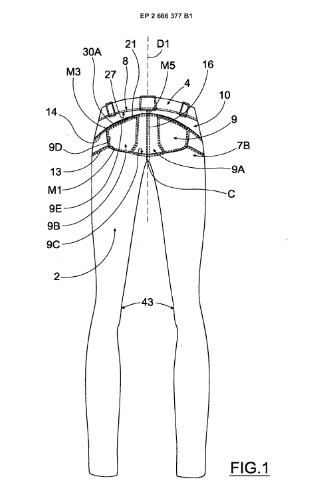
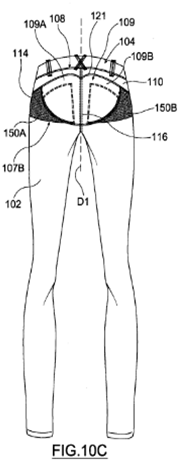
The Skilled Team
- There is nothing in the Amended Defence to assist me in identifying the skilled person or team. Ms Rogan's evidence on this point is therefore unchallenged. Ms Rogan provided in her witness statement a breakdown of the various disciplines and commercial entities that might be involved in developing a new product such as body-shaping outerwear as described in the Patent, including material manufacturers, garment manufacturers, brand owners and retailers. Within each of these entities, she said, there would be designers, fabric and materials technologists and experts in garment manufacture. Ms Rogan also provided her opinion on the garment type closest to the pants referred to in the Patent, looking, as comparators, particularly at underwear, swimwear, sportswear, and outerwear. Whilst jeans would traditionally be considered outerwear, and "pants" in the Patent is used to refer to outerwear, it was Ms Rogan's view that the skilled underwear team would have the closest connection to the pants described in the Patent because of the expertise required to make them.
- Based on her evidence, counsel for the Claimant therefore proposed the following skilled team:
"A team working on the development and manufacture of designs for underwear, led by a designer and including experts in fabrics technology and manufacturing processes."
- I accept that definition of the skilled team. It also has the advantage of being consistent with the prior art identified by the Defendants, the majority of which were forms of underwear.
Common General Knowledge
- Ms Rogan opined, and I accept, that the Common General Knowledge (CGK) in this case includes knowledge of:
i) knitted stretch cotton jersey leggings that have the appearance of jeans, known as "jeggings";
ii) skinny, stretch jeans whose composition includes elastane yarn;
iii) smoothing, flattening and shaping underwear garments;
iv) how to work out how pattern pieces should be fitted together;
v) the operation and purpose of the various machines used in textile manufacture;
vi) fabrics with different elastic modulus, including woven fabrics and warp knitted fabrics;
vii) the use of lining mesh and laminates to provide stiffening, and elastics of silicon to prevent slippage;
viii) the use of three-dimensional design for the purpose of circular knitting machines;
ix) the use of layers and different stitch types to create shape and support;
x) the use of different yarns to achieve weight and finish;
xi) the relationship between fabric choice and "drape";
xii) methods for bonding or laminating silicon or polyurethane linings and films; and
xiii) the behaviour of stretch fabrics, including the requirements to rest fabric after cutting, and the particular sewing requirements for such fabrics.
Novelty
- The Amended Defence pleaded lack of novelty over:
i) United States Patent Application no US 2004/0111781A1 (Miyake); and
ii) PCT Application WO 2008/063259 A I (Kennedy).
- Ms Rogan was given the prior art, and asked to consider it in detail, prior to being shown the Patent: see Medimmune Limited v Novartis Pharmaceuticals UK Limited and Anor [2011] EWHC 1669 (Pat) per Arnold J (as he then was). She helpfully summarised the contribution of each of the prior art citations.
- Miyake is a girdle or athletic tight made from a conventional cut and sew construction covering the waist and legs. Fig 15 of Miyake is as follows:
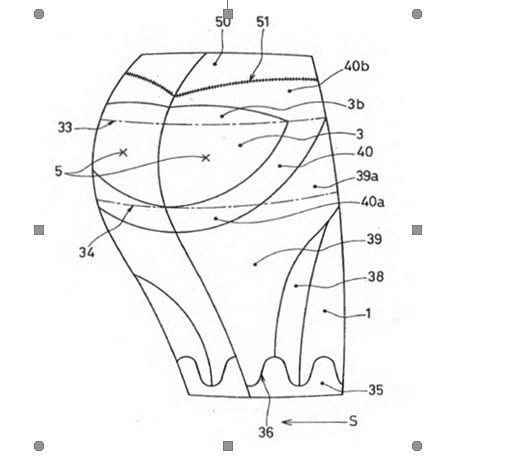
- The parts marked 1 and 3 are said to be easily stretchable portions, with the other parts generally disclosed as being of higher modulus.
- As Ms Rogan notes, contrary to claim 1, Miyake does not disclose pants (in the sense of outerwear). Miyake could be made on a type of fabric manufacturing machine called a "warp knit jacquard machine" with the whole of the rear of the garment in a single piece. Miyake provides for a single seam joining the girdle from waist to hem: there is no adaptation for positioning a seam in the intergluteal cleft.
- Kennedy is a seamless underwear garment made on a circular knitting machine, with integral support panels to flatten or compress the stomach, hips and upper thighs.
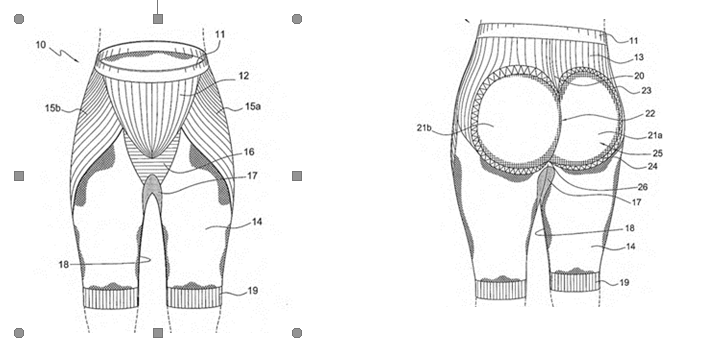
- The front view from figure 1 of Kennedy, above, shows the support panels, labelled 12, 15a, 15b and 16. The panel around the buttocks, labelled 21b on the rear view, is made from a lighter jersey knit.
- As Ms Rogan notes, Kennedy is also an undergarment, rather than outerwear as claimed in the Patent. It is knitted in one piece, not in separate parts or elements. There is no central seam or indeed any seam in the intergluteal cleft.
- Ms Rogan's evidence is clear: I have no hesitation in finding that the Defendants claim for lack of novelty over Miyake and Kennedy fails. I add for completeness that the Claimant only set out what its counsel described as "the most glaringly obvious absences in relation to the main claim of the Patent". It is unnecessary to delve any further into less obvious differences between the prior art and the invention disclosed in the Patent.
Obviousness
- The Defendants also pleaded obviousness over Miyake and Kennedy, and two further pieces of prior art:
i) US Patent NO 3,996,622 (Cooke); and
ii) US Patent Application NO US2007/0199134 A1 (Duckman).
- Cooke teaches close-fitting comfortable trousers:
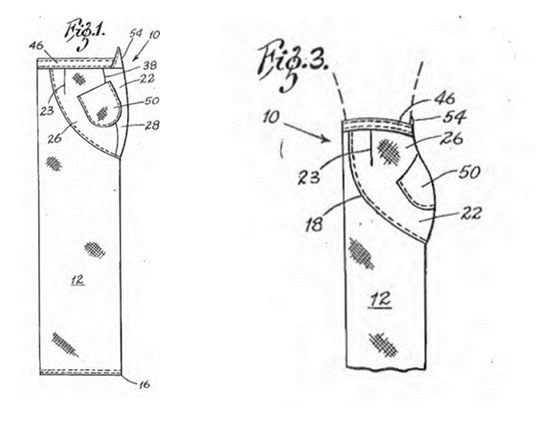
- The trousers include a seat portion (shown at 22 in the figures above) which is described as shaped to fit the buttocks. There is no teaching of any resilience in the fabric deployed by Cooke.
- Duckman discloses hosiery, created on a circular knitting machine. Duckman has support panels for smoothing the stomach and hips and a looser, knitted panel for the buttocks.
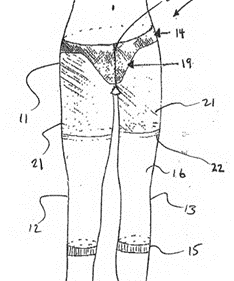

- Much of the disclosure in Duckman relates to the leg portions, with the upper leg part (shown as 21 in the figure above) being a double layer of net. The waist panel (14 in the figure above) is a tighter knit including spandex and nylon.
- Counsel for the Claimant reminded me that obviousness is a question of fact. I have before me Ms Rogan's detailed report, which explains why, in Ms Rogan's opinion, the skilled underwear team would not find it obvious to adapt any of the four pieces of prior art so as to fall within claim 1 of the Patent. In the absence of any evidence from the Defendants, counsel for the Claimant submitted that there is no reason on the face of Ms Rogan's report to suggest I should discard or discount her views. I agree. Ms Rogan's report was, as I have said, carefully prepared and convincing. The facts on which she relies are set out in her report. I have read Ms Rogan's report in detail and accept her evidence as to the facts on which she relies to support the opinions she has expressed: nothing is to be gained by setting her report out in full here. Suffice to say that Ms Rogan sets out the steps she considers it would be obvious for the skilled team to take in light of the CGK, and none of them comes close to falling within claim 1 of the Patent.
- I have no hesitation in concluding that the Patent is not obvious over Kennedy, Miyake, Duckman and Cooke.
- In my judgment, the Patent is not invalid for novelty or obviousness over the prior art pleaded by the Defendants.
Patent Infringement
- As I have set out above, the Defendants admitted that the First HUGZ Jeans fell within claim 1 of the Patent. The Second HUGZ Jeans were, according to the Amended Defence, a design around. There was only one change, which is illustrated in the following photograph, showing the rear of the Second HUGZ Jeans turned inside out.
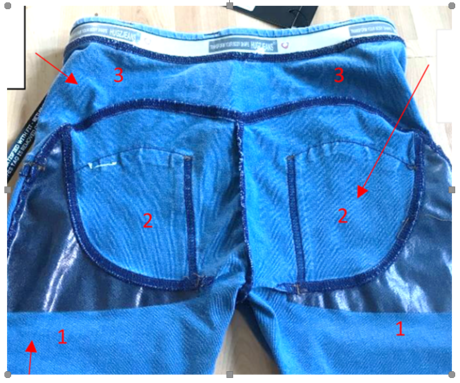
- The third element referred to in the Patent (adapted to cover at least an upper terminal portion of the buttocks) is labelled 3. This is unchanged as between the First HUGZ Jeans and the Second HUGZ Jeans. The second element referred to in the Patent (adapted to cover at least a central portion of the buttocks) is labelled 2. The first element referred to in the Patent (adapted to cover at least a lower terminal portion and lateral portion of the buttocks) includes the fabric shown in the picture as shiny, because it is covered by a silicone panel, and the non-shiny fabric at the upper leg, labelled 1. The alteration between the First HUGZ Jeans and the Second HUGZ Jeans was as follows:
i) on the First HUGZ Jeans, the curved seam along the base of the pockets continued towards and met at roughly a right angle with the seam positioned in the intergluteal cleft, in effect joining the piece of fabric labelled 1 to the piece of fabric labelled 2.
ii) on the Second HUGZ Jeans, there was no such seam, because a single piece of fabric made up the areas labelled both 1 and 2.
- Counsel for the Claimant put the construction question as follows:
"[w]hether the first and second element of the claim must be made from entirely separate pieces of fabric, or whether they can instead be substantially distinct pieces, that remain joined by a small bridge of fabric to each other."
- No assistance is given in the Patent itself as to the meaning of "element", and/or whether claim 1 requires elements 1 and 2 to be separate pieces of fabric. I note that the Patent also uses the expression "part", but it is not clear as to whether "part" means simply less than the whole, or whether a "part" is required to be fully separable.
- Ms Rogan was unimpressed with the distinction relied on by the Defendants in the Amended Defence to argue that the Second HUGZ Jeans did not fall within claim 1. She stated in her report:
"The [second] HUGZ jean has the three elements as described covering the buttocks as shown in Exhibit TR-3 at points 1-3 [the photograph set out above at paragraph 55]. As to the first and second elements, when I unpicked the jeans, at first there appeared to be four pieces of fabric in the seam below the buttock, as the upper edge of the lower (first) element was folded over, but I confirm that three pieces of fabric are used to create the seam namely the fabric below the cut, the fabric above the cut (which to my mind is a second element), and the fabric of the false pocket. The edge of the fabric below the cut is folded over so that the seam has four layers of fabric. In addition the edge of the silicon insert is sewn into the seam as a fifth layer. This creates a very solid supporting seam
The first and third elements (the leg and yoke respectively) are joined together by the area of fabric between them, which is sewn to the bottom edge of the yoke and the bottom edge of which (created by a cut in the fabric) is sewn to the top of the leg in the manner described above so as to create a substantial seam separating the two areas. In other words the area of fabric above the cut has to be sewn into place to fill the gap or aperture between the bottom of the yoke, and the cut which goes from the yoke down and then across almost all the way to the central vertical seam, so as to close it. I think this area of fabric would be understood by the skilled person as a second element in the terms of the Patent, since it covers the buttock, is separate at every point except between the inner edge of the rear pocket and the vertical seam (which itself is formed by sewing the rectilinear edges of the two pieces of the second element together), and has to be sewn into place around all its edges."
- In short, it was Ms Rogan's position that the various elements are described as they are in order to achieve the purpose of the article of clothing which is constructed as a result. In both the First HUGZ Jeans and the Second HUGZ Jeans, the seams are in the positions described, including the long, curved seam that runs along the base of the false rear pocket towards the intergluteal cleft seam. Those seams are in the same position on both the First HUGZ Jeans and the Second HUGZ Jeans, save that on the Second HUGZ Jeans, the seam is slightly foreshortened, and terminates before it meets the intergluteal cleft seam.
- As I have said, I found Ms Rogan's report to be carefully prepared and convincing and I accept her position. It does not seem to me that, to make sense of the Patent, it is necessary to construe "element" as meaning "totally separate piece of material". Indeed, Ms Rogan considers that that is unnecessary. Rather, she says that the skilled team would consider the portions labelled 1 and 2 above to be separate "elements", even with the interconnecting bridge of fabric between the larger first and second elements. I agree that that is a normal construction of claim 1, based on an interpretation of the words of the claim in the context of the specification as a whole: Regen Lab SA v Estar Medical Limited and Ors [2019] EWHC 63 (Pat) per HHJ Hacon sitting as a High Court Judge at paragraph 207.
- The Second HUGZ Jeans therefore infringe claim 1 of the Patent.
- I was also asked to consider equivalents, as set out by the Supreme Court in Actavis UK Limited v Eli Lilly & Co [2017] UKSC 48. In Icescape Limited v Ice-World International BV and Ors [2018] EWCA Civ 2219, Lord Kitchin said at paragraphs 66 and 67:
"[66] The whole approach to interpretation and scope of protection therefore involves the following steps, considered through the eyes of the notional addressee:
i) Does the variant infringe any of the claims as a matter of normal interpretation?
ii) If not, does the variant nevertheless infringe because it varies from the invention in a way or ways which is or are immaterial? This is to be determined by asking these three questions:
a) Notwithstanding that it is not within the literal (that is to say, I interpolate, normal) meaning of the relevant claim(s) of the patent, does the variant achieve substantially the same result in substantially the same way as the invention, i.e. the inventive concept revealed by the patent?
b) Would it be obvious to the person skilled in the art, reading the patent at the priority date, but knowing that the variant achieves substantially the same result as the invention, that it does so in substantially the same way as the invention?
c) Would such a reader of the patent have concluded that the patentee nonetheless intended that strict compliance with the literal meaning of the relevant claim(s) of the patent was an essential requirement of the invention?
[67] Of course, in order to establish infringement in a case where there is no infringement as a matter of normal interpretation, a patentee would have to establish that the answer to questions (a) and (b) above is 'yes' and that the answer to question (c) is 'no'."
- Ms Rogan's evidence on the first and second Actavis questions was clear. She said that the Second HUGZ Jeans achieve the same result in the same way as the Patent. She considered that use of a short bridge of fabric instead of a seam has no practical effect on the way the invention works, because the resulting "elements" do the same task in the same way, and the resulting seams (the curved seams along the base of the false pockets) work in the same way as in the Patent. She noted:
"At the point where the seam ends, the buttock merges into the intergluteal cleft and there is not much flesh to support. The fact that the lateral seam is fractionally shorter than it otherwise would have been will not make any significant difference to the overall effect that the curved seam and central seam have to outline and to separate the buttocks. Nor does it affect the way in which the insert panels work to smooth the hips and lift the buttocks. The connection between the lateral seam and the central vertical seam may be a little less firm, but I do not believe that this will make any real difference."
- In relation to the second Actavis question, Ms Rogan says that these considerations would be known to the skilled team as at the priority date.
- Counsel for the Claimant submitted that the third Actavis question acts as a check on the first two, and invites a defendant to point out any material in the patent which might drive the court to conclude that the patentee really wanted the claim to be strictly construed so as to exclude variants that were established by the first two questions to be immaterial. Typically, he said, this will involve an item of prior art that is acknowledged by the patent, or a piece of CGK that the patentee would, in the views of the skilled person, want to avoid. He submitted that there is no such material before me. I agree. Not only is none of the pleaded prior art mentioned in the Patent, I have found it could not be described as close or otherwise limiting on the Patent, particularly in relation to this particular seam. I have no hesitation at all in finding that, had I found that the Second HUGZ Jeans did not fall within a normal interpretation of the Patent, I would have found infringement under the doctrine of equivalents.
Passing Off
- The law of passing off, as set out in Reckitt & Colman Products Limited v Borden Inc and Ors [1990] RPC 341 (Jif Lemon) is well known, so I will not set it out here. To succeed in its claim, the Claimant must prove goodwill, a misrepresentation by the Defendants, and damage by reason of the erroneous belief engendered by the Defendants' misrepresentation.
Goodwill
- The Claimant asserted goodwill in the combination of following elements of its WR.UP jeans (referred to in the pleadings as the Freddy Get-Up):
i) "a polished metallic badge approximately 15mm high and 15mm wide;
ii) which badge is, save for a narrow border, painted in a pale gloss colour;
iii) which badge features an abstract motif;
iv) which badge is positioned very close to the upper seam of the rear right pocket of the jeans;
v) which badge is positioned close to the outer seam of the rear right pocket of the jeans;
vi) two rear pockets each having two curved seams and one substantially straight seam;
vii) at least one central rear belt loop sewn at an angle to the vertical of approximately 40 degrees; and
viii) a scalloped rear yoke".
- These elements of the Freddy Get-Up can be described in words, but are perhaps best illustrated by images of the rear of the WR.UP jeans:
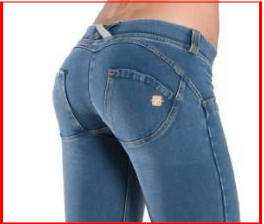
- The Defendants admitted that the Claimant sold the WR.UP jeans bearing the Freddy Get-Up, however, the Amended Defence averred that the Claimant's jeans are sold by reference only to the brands FREDDY and WR.UP, and that therefore any goodwill and reputation in the UK relates to the FREDDY and WR.UP brands, which the Defendants do not use. The Defendants also put in issue the question of whether it is customary and conventional for women's jeans to bear branding elements on their rear pockets.
- Ms Rogan's evidence on the latter issue was clear:
i) Customers expect to see branding on jeans, including as part of the garment itself;
ii) Branding elements are typically added to the back of jeans as this is the largest area to which to add details. The back pocket area is usually highly visible when the jeans are worn. Ms Rogan gave the example of the iconic red tab on Levi's jeans;
iii) Branding elements are often added to the waistband;
iv) The branding elements are to ensure that the jeans are easily recognisable, both to consumers buying their products and also to those seeing people wearing their products;
v) It is important for a brand or designer that customers and potential customers can easily recognise their products on the wearer from a reasonable distance;
vi) Customers want to be seen in particular brands; and
vii) Common branding elements on the rear of jeans include leather or fabric tabs, the shape of pockets, the stitching on the pocket, and metal rivets or bartacks at the corners of pockets.
- Ms Rogan also gave specific evidence about the Freddy Get-Up:
"In my view, each of these branding elements accords with the tradition of having brand identifiers on the rear of the jeans. As a result, they are likely to be seen by customers as indicating the source of the jeans. However, Freddy's execution through its particular choices of branding elements is unusual and distinctive."
- Although it is the objective view of consumers that matters, rather than the subjective view of the designer, Ms Rogan's opinion is also consistent with what Mr Freddi said he set out to do he gave evidence that he wanted to ensure that someone walking behind a customer wearing WR.UP jeans "would instantly recognise it as being our product".
- If it was realistically in doubt, it is clear to me from Ms Rogan's evidence that it is customary and conventional for women's jeans to bear branding elements on their rear pockets. It is also clear to me from the evidence provided by Mr Freddi that the Claimant set out to, and in fact did, market the WR.UP jeans by drawing attention to the Freddy Get-Up. Further, it is clear to me that at the time of the launch of the HUGZ jeans, consumers were aware, through the Claimant's marketing efforts, of the Freddy Get-Up, and had been educated that the Freddy Get-Up on jeans is an indication of origin. The Claimant therefore owns goodwill in the Freddy Get-Up.
Misrepresentation and Damage
- The Claimant alleged that the Second HUGZ Jeans had been promoted and offered for sale under and by reference to the following get-up (the HUGZ Get-Up):
i) "A polished metallic badge of approximately 15mm high and 15mm wide;
ii) Which badge is save for a narrow border, painted in a pale gloss colour;
iii) Which badge features an abstract heart-shaped motif;
iv) Which badge is positioned very close to the upper seam of the rear right pocket of the jeans;
v) Which badge is positioned close to the outer seam of the rear right pocket of the jeans;
vi) Two rear pockets each having two curved seams and one substantially straight seam;
vii) At least one central rear belt loop sewn at an angel to the vertical of approximately 40 degrees; and
viii) A scalloped rear yoke".
- The Claimant's WR.UP jeans are shown below on the left: the First HUGZ Jeans are shown on the right (and differ from the Second HUGZ Jeans in relation to the seam described above):
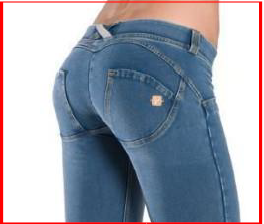
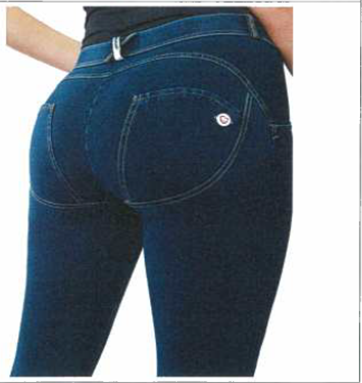
- Counsel for the Claimant suggested that I assess the misrepresentation and damage elements of passing off together. As the Claimant and the First and Second Defendants are competitors, he said, it follows that if the Defendants have misrepresented a trading connection with the Claimant, damage is inevitable. He referred me to the 5th edition of The Law of Passing Off by Christopher Wadlow at paragraph 4-14:
"A misrepresentation that the defendant's goods or business are those of the claimant is intrinsically likely to damage the claimant if the fields of business of the claimant and defendant are reasonably close. The fact that virtually every successful passing off action for half a century fell into this category meant that an inquiry as to damages could be granted as a matter of routine if the other elements of the tort were made out."
- In her report, Ms Rogan said this:
"I noticed that the marketing for both the [Claimant's] jeans and the [Defendants'] jeans focuses on the back of the jeans. This is not unusual; as I mention above, the back of the jeans is a common focus for branding elements. What is unusual, in my view, is that [the Defendants have] adopted the same branding elements as [the Claimant]. As I have said, these are not common features themselves, and my opinion is that they have adopted the same features in order to associate themselves with [the Claimant].
I cannot know the real reasons why they wanted to create this association, but it is clear to me that they wanted consumers to believe either (a) that the two brands are connected in some way, or (b) that a consumer, even if it knows that [the Defendants are] unconnected to [the Claimant] when buying the product, wanted other consumers to believe that the [Defendants'] product was associated with [the Claimant] and its product."
- Counsel for the Claimant described the former of these two associations as conventional passing off, and I have no hesitation in finding that such passing off is made out in this case. The Second HUGZ Jeans are an obvious rip-off of the WR.UP jeans. The Defendants have clearly adopted very similar branding elements, which, as Ms Rogan says, consumers will recognise as an indication of origin. That is clearly the Defendants' intention as Ms Rogan says, the Defendants promote the Second HUGZ Jeans (particularly with on-line sales) by reference to HUGZ Get-Up, which is very similar to the Freddy Get-Up. Whilst there are minor differences (differences in the image on the metallic badge, only one diagonal belt-loop), these are insufficient to dispel the misrepresentation caused by the other elements. I also note that it does not matter that the trade mark under which the Second HUGZ Jeans are sold is different. The rear branding elements which comprise the HUGZ Get-Up are sufficiently strong that that is what consumers recognise: see the speech of Lord Oliver at page 411 in Jif Lemon. In my judgment, the Second HUGZ Jeans misrepresent, through the HUGZ Get-Up, that there is a connection in the course of trade with the Claimant. As a result, the Claimant has already suffered damage, and will continue to do so whilst the Second HUGZ Jeans remain on sale. That damage includes the lost sales referred to in Mr Freddi's evidence.
- The position with respect to post-sale confusion is less clear. This is the second type of misrepresentation referred to by Ms Rogan, whereby a consumer knows she is purchasing a knock-off when she buys the Second HUGZ Jeans, but she does so because she wants other consumers to believe that her jeans are associated with the Claimant and its products.
- It is now well-established that such confusion is actionable as a matter of trade mark law: see Datacard Corporation v Eagle Technologies Limited [2011] EWHC 244 (Pat) per Arnold J (as he then was). After reviewing the European jurisprudence on post-sale confusion, at paragraphs 288 and 289, Arnold J said this:
"288. Finally, as a matter of principle, I find it difficult to see why it should matter if confusion only arises after the goods have been sold. Suppose that a consumer orders goods from a third party's website and, at the time of ordering, is not confused as the trade origin of the goods; but when the goods arrive some days later, the goods are labelled in a manner which wrongly leads the consumer to believe that the goods emanate from the trade mark proprietor. Why should such confusion not be actionable? It falls within the scope of a contextual assessment of the use of the sign. It is surely capable of being damaging to the trade mark proprietor. For example, it may cause the consumer to obtain the goods from the same website the next time he or she orders those goods under the same mistaken belief. And why should it make any difference for these purposes whether the goods are labelled with a sign identical to the trade mark or merely one that is similar to the trade mark i.e. whether the case falls within Article 5(1)(a) or 5(1)(b)?
289. Accordingly, I conclude that in appropriate circumstances post-sale confusion can be relied upon as demonstrating the existence of a likelihood of confusion under Article 5(1)(b)."
- Datacard was a trade mark case, but Counsel for the Claimant submitted that the reasoning set out there is also apposite in passing off.
- The question appears to have been considered by judges at first instance in this court on very few occasions. In Bostick Limited v Sellotape GB Limited [1994] RPC 556, Blackburne J appeared to suggest that post-sale confusion is insufficient for a finding of passing off. In that case, the claimant and defendant both sold a blue coloured re-usable adhesive tack, but under different brands and in different packaging such that there was no evidence of point of sale confusion. An interlocutory injunction was refused because the claimant failed to establish an arguable case of passing off. Counsel for the Claimant submitted that any findings in this case were obiter. In any event, Blackburne J did not rule out the relevance of post-sale confusion in passing off cases: he did not find it out made out on the facts of that case.
- Counsel for the Claimant also referred me to Laddie J's findings in Arsenal Football Club PLC v Reed [2001] EWHC 440 (Ch) that passing off was not established because the claimant could not prove misrepresentation had taken place when consumers knowingly purchased unofficial Arsenal merchandise. Laddie J expressly relied on the disclaimers Mr Reed posted on his store, as well as the price differential between the genuine Arsenal merchandise and that sold by Mr Reed. Laddie J referred preliminary questions on trade mark law to the Court of Justice. Following Laddie J's further judgment ([2002] EWHC 2695 (Ch)), the matter proceeded to the Court of Appeal ([2003] EWCA Civ 696), which overturned the trial judge in relation to trade mark infringement. His passing off findings were not subject to the appeal: nevertheless, Aldous LJ (with whom Clarke and Jonathan Parker LJJ agreed) said that he was not convinced that Laddie J's passing off reasoning was correct.
- Other than these two cases, counsel for the Claimant could not point me to any relevant decisions of this court or the Court of Appeal that deal squarely with the issue. He did, however, rely on a decision of the High Court of New Zealand with striking parallels to this case: Levi Strauss and Co and Anor v Kimbyr Investments Limited [1994] FLR 335. In that case, Levi Strauss relied on the red tab on the rear pocket of its jeans to claim trade mark infringement and passing off against the defendant, which also used a fabric tab on the rear pocket of its jeans. Williams J found both trade mark infringement and passing off, even though most purchasers would not themselves be confused at the time of purchase. In relation to trade mark infringement, his Honour said this at page 381:
"The whole point of this particular mark is to maintain the connection between the goods and the proprietor during the life of the garment after sale. There is no reason in principle why this aim should be frustrated. It is a legitimate and classic use of a mark. If the Kimbyr argument is correct the purpose of this mark would be negated. A defendant could insert a deliberately misleading mark on a garment, ensure that there was no confusion at point of sale, but continue to gain the benefit of its unethical trading by arguing that the confusion happened after sale only. This kind of result would cut against the clear objective of the trade marks legislation which is to support the use of trade marks to distinguish the goods of one manufacturer or trader from others and to minimise public confusion. To the extent that the protruding tab is a novel kind of mark, the court must respond appropriately to modern business developments: see the observations of Whitford J in Unidoor Ltd v Marks and Spencer plc [1988] RPC 275."
- Having found that Levi Strauss's red tab trade mark had been infringed, Williams J turned to passing off. In dismissing the defendant's argument that the price differential between the Levi's jeans and the alleged infringement would dispel any misrepresentation, Williams J said this (emphasis added):
"In my view the fact that the Levi's Red Tab jeans are more expensive than Kimbyr's jeans does not help the defendant in this case. Once the jeans have been purchased then price becomes irrelevant; the only issue is the effect that the tab has in linking the jeans with the correct proprietor. But, in any event, for many would-be purchasers who associate a tab with Levi's jeans the price differential between the plaintiffs' jeans and the defendant's jeans would be irrelevant. For others the possibility of buying a cheaper pair of jeans with a red tab which could be passed off as the plaintiffs' jeans would be very attractive to some purchasers."
- He went on to conclude:
"In summary, both for these reasons and those given earlier when dealing with post-sale confusion in relation to trade mark infringement, I hold that it is irrelevant that the confusion might not take place at the point of sale except in a comparatively small number of cases. Since the misrepresentation is continuing to be caused by the Kimbyr jeans and it is damaging the reputation or goodwill of the plaintiffs, the cause of action has been established. The owner of the goodwill in a product is entitled to have this goodwill protected throughout the life of the product not just at the point of sale. Once again the purpose of the Levi Strauss mark is relevant. Since the plaintiffs have satisfied the court that the protruding tab device continues to operate as an effective badge of ownership connecting the jeans with the proprietor it is inevitable that Kimbyr actions in adopting a similar mark, for presumably the same purpose, must cause Kimbyr jeans to be passed off as Levi's."
- Whilst it would have been preferable to have heard arguments on both sides, I can find nothing in the cases to which I was taken to suggest that it would be inappropriate for me to follow the reasoning of Williams J. Post-sale confusion has been embraced in trade mark infringement cases, and I see no reason on the facts of this case not to follow his Honour's reasoning. As William J said, the owner of goodwill in a product is entitled to have this goodwill protected throughout the life of the product, not just at the point of sale. Ms Rogan's evidence was that the HUGZ Get-Up will continue to make misrepresentations whenever the HUGZ jeans are worn. On the facts of this case, that misrepresentation damages the Claimant.
- I therefore find that the Defendants have passed off the Second HUGZ Jeans on the basis of Ms Rogan's evidence of misrepresentation at point of sale, and post-sale.
Unregistered Designs
- The Claimant claims infringement of the following unregistered design rights under the CDPA (collectively called the WR.UP Designs):
i) The shape of the WR.UP jeans when worn (the When Worn Design). The When Worn Design was further described as follows:
"The parts of the WR.UP jeans surrounding the buttocks of the wearer are substantially resilient, have varying resiliencies, and are accordingly liable to impose a distinctive shape upon the wearer. That shape will necessarily be influenced by the body shape of the wearer. Nonetheless, for all wearers the design of the WR.UP jeans procures a distinctive shape, the significant features of which are that the wearer's buttocks are both lifted and separated. This distinctive shape can be seen from the images [below]"
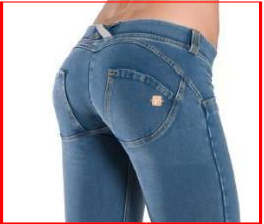
ii) The shape of the internal rubberised support panel (the RSP Design). The RSP Design was further described as follows:
"This panel is found on the inside of the garment underneath each of the rear pockets, adhered to the knitted fabric of the garment. The shape of the left panel is a vertical reflection of the shape of the right panel. The design covers the whole shape or the rubberised support panel. The significant features of the design are:
i. The rubberised support panel follows the curve of the lower seam of the central panel and rear pocket and lies below it;
ii. The rubberised support panel extends vertically towards the lower seam of the yoke and laterally towards the side seam; and
iii. The lower edge of the support panel coincides approximately with the point where the wearer's buttocks meet the rear upper thigh.
Images illustrating these features are [below]."

iii) The shape and/or configuration of the inner parts of the upper rear portion of the garment (the Inner Parts Design). The Inner Parts Design was said to be comprised of the following significant features:
i) The shape and/or configuration of the internal rubberised support panels;
ii) The shape and/or configuration of the internal rubberised belt portion;
iii) The shape and/or configuration of the adjacent and/or associates knitted fabric panels; and
iv) The position of the seams of those panels, shown below:
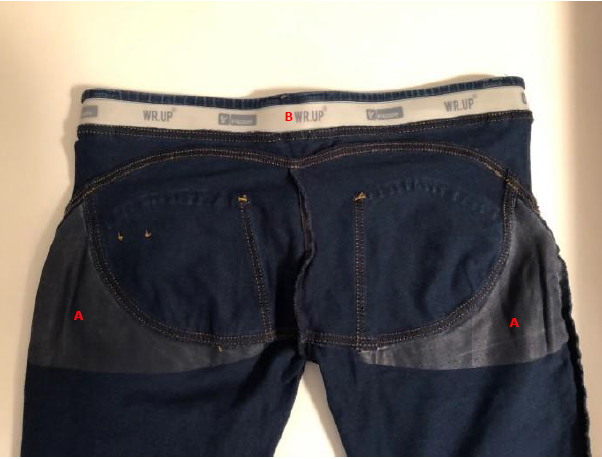
- If I reject the claim to design right in the When Worn Design, the Claimant advanced in the alternative infringement of the shape/configuration of the jeans on their own, including the elastic nature of the fabrics and materials making up the garment, and seam positions, but excluding buttons, zips and stitching (the JOTO Design). The significant features of the JOTO Design were said to be:
i) the shape and/or configuration of the knitted fabric panels; and
ii) the shape and/or configuration of the internal rubberised panels.
- As set out above, Mr Freddi gave detailed evidence as to the process of designing the WR.UP jeans, which I have accepted. That evidence establishes that the designs relied on are original (in the sense that they were not copied from any third party design) and that the designs are owned by the Claimant.
- As set out above, the Defendants admitted that they had copied the WR.UP jeans to create the First HUGZ Jeans, with the only difference in the Second HUGZ Jeans being the curving false pocket seam foreshortened prior to meeting the intergluteal cleft seam. The Defendants did not point to any other differences between the pleaded designs and the Second HUGZ Jeans. Rather, they raised in their Amended Defence two main types of objections to the WR.UP Designs: first, two definitional objections in relation to aspects of the When Worn Design and the JOTO Design and, second, four exclusions from protection under the CDPA which were said to apply.
- Additionally, the Inner Parts Design was said to be commonplace, an allegation that must fail in the absence of any evidence of prior designs to support it. Further, allegations that features of the claimed designs were not "significant" also fail on the basis that there is no evidence to support such an assertion, and substantial contrary evidence from Ms Rogan.
- I deal first with the two definitional issues.
When Worn Design
- There was what I might describe as a definitional objection which relates only to the When Worn Design. Put simply, the objection was that the shape of a pair of jeans "when worn" is not a protectable design, because it is a shape which is infinitely variable depending on the particular person wearing the jeans. Put another way, the Amended Defence claimed "the design is not the shape or configuration of an article as such, but the shape and configuration adopted by an article as produced where worn by a particular individual".
- In response, Ms Rogan set out in her witness statement what the Claimant's counsel described as "a comprehensive explanation why the shape created by the WR.UP jeans is predictable". I accept Ms Rogan's explanation, as far as it goes. However, the difficulty I have is that the Amended Particulars of Claim aver that the shape the jeans take when worn "will necessarily be influenced by the body shape of the wearer". It is not enough to say that all wearers will have their buttocks both lifted and separated by the WR.UP jeans. I must assess the design as claimed. The Claimant itself avers that the shape of the jeans "when worn" will in part be determined by the shape of the wearer, and, even within a range of body shapes that would fit a given size of jeans, there will be a significant variation in body shapes. There was no evidence to say that the variously shaped wearers would all end up shaped the same when wearing the jeans. I accept Ms Rogan's evidence that the wearers' buttocks would be lifted and separated, but if those buttocks are of differing shapes, the resultant shapes of the jeans "when worn" will differ.
- In his oral submissions, counsel for the Claimant put this slightly differently. He described the shape of the jeans when worn as "a lens through which one can, and in this case should, analyse the shape of the article itself". Counsel for the Claimant drew an analogy with a balloon, the rubber of which was of differing characteristics with different elasticities. When inflated, the balloon would not adopt a uniform shape. He said "when it is in its packet, it looks like a normal balloon, but when it is inflated, it adopts a fantastic shape of an animal. And the design that is
assert[ed] is the shape of the product when it is inflated." I do not accept that his analogy is useful here. Air blown or pumped into a balloon will take the shape of the balloon, because the air within the balloon is at a consistent pressure throughout. A human body part inserted into a balloon will not take the shape of the balloon rather, the balloon will take the shape of the body part.
- I therefore accept the Defendants' pleaded case that the When Worn Design is invalid on the basis that, as pleaded, it does not constitute a protectable design.
The JOTO Design
- Having rejected the subsistence of the When Worn Design, I must consider in the alternative the JOTO Design. This asserts the design in the WR.UP jeans alone (that is, without being worn), including the configuration of the various shaping panels. This design, as defined, is not reliant on the human body shape, and so the accusation made in relation to the When Worn Design does not apply.
- However, the Amended Defence makes a further complaint in relation to the JOTO Design, which claims the elastic nature of the fabrics and materials making up the WR.UP jeans. The Amended Defence pleads that the elastic nature of the fabrics and materials (1) are not features of its configuration and/or (2) are methods or principles of construction.
- In relation to configuration, the Amended Particulars of Claim define the JOTO Design as "the shape and configuration of the WR.UP jeans themselves on their own, such configuration to include the elastic nature of the fabrics and materials making up the WR.UP jeans" (emphasis added). The issue is therefore whether "configuration" allows for any consideration of the movement of an article.
- Counsel for the Claimant referred me to the decision of Pumfrey J (as he then was) in JCM Seating Solutions Limited v James Leckey Designs Limited [2002] EWHC 3218 (Ch), an application to strike out a claim made for design infringement or alternatively for summary judgment. The design was for a seating system, with two adjustable parts. Whilst Pumfrey J found that the design claimed was a method or principle of construction, he did not appear to have any difficulty with the design on the basis that it encompassed movement.
- It seems to me that the notion of shape and configuration in unregistered design law is a broad one, and therefore ought to be able to encompass the concept of movement. I see no reason why unregistered design law ought not protect, for example, the shape and configuration of a collapsible bowl, or a sofa bed. Certainly, many of the designs referred to in the case law of this court are for articles which have been capable of being moved (including, for example, the umbrella case in A Fulton Co Limited v Grant Barnett and Co Limited [2001] RPC 16 or the suitcase in Magmatic Limited v PMS International Limited [2013] EWHC 1925 (Pat): Arnold J's findings in relation to unregistered design rights were not disturbed on appeal.
- Here, the Claimant's counsel's balloon analogy is more appropriate. The JOTO Design is defined to include the elastic nature of the fabrics and materials. This is not a claim to those materials as stretched by differently shaped human bodies rather, it is a claim to their elastic nature. I consider that to constitute the shape and/or configuration of an article, and therefore to be protectable, as defined.
- I deal next with the four statutory exclusions from protection, including method or principle of construction.
Method or Principle of Construction
- Section 213(3)(a) of the CDPA excludes from unregistered design protection "a method or principle of construction". This expression has been held to exclude two types of claims. First, the exception has been used to exclude protection for abstract claims that are expressed too broadly beyond a claim to shape and/or configuration. Whilst a degree of abstraction is permitted, if the claim is taken too far, it will be found to be a method or principle of construction: DKH Retail Limited v H Young (Operations) Limited [2014] EWHC 4032 (IPEC) per HHJ Hacon. Second, the statutory exception prevents design right attaching to the manner in which the shape of the article is put together. As Park J stated in A Fulton Co Limited v Grant Barnett & Co Limited [2001] RPC 16 at paragraph 70:
"It is certainly true that there are methods of construction involved in the creation of the Miniflat case. One is the method whereby the case retains its rectangular box-like shape when the umbrella is not contained within it. Another is the stitching technique which creates the outward-pointing seams on the edges and at the corners of the case. However, the design of the case is the shape or configuration produced by those methods of construction, not the methods by which that shape or configuration is produced. The fact that a special method or principle of construction may have to be used in order to create an article with a particular shape or configuration does not mean that there is no design right in the shape or configuration. The law of design right will not prevent competitors using that method or principle of construction to create competing designs (of course other areas of the law, like patents, might prevent competitors doing that), as long as the competing designs do not have the same shape or configuration as the design right owner's design has."
- The Defendants levelled this objection at the RSP Design, on the basis that it "amounts merely to the application of a rubberised panel attached to a particular area of a pair of jeans
in order to aid the shaping of the lower buttocks, and accordingly is a method or principle of construction". This would appear to rely on the first sort of method or principle of construction set out above that the design claimed is too abstract to be protectable as a design. I disagree. The design asserted is the precise shape of the rubberised panel, which the Defendants have copied exactly. There is no need for the Claimant to abstract its design in order for the Defendants' product to fall within its scope, and it has not done so. This objection fails.
- This objection is also levelled at the Inner Parts Design, which is an expanded version of the RSP Design. The objection fails for the same reasons as set out in the previous paragraph.
- Finally, this objection is also levelled at the JOTO Design. The Amended Defence claimed that "the nature" of the elastic fabrics and materials "reflects methods or principles of construction". This would appear to be the second type of objection caught under this statutory provision, as set out in Fulton. However, this pleading misunderstands the statutory exception. The Claimant conceded that a knitted fabric is a method or principle of construction, as is the application of the rubberised panels but that is not the design that is being claimed here. The JOTO Design is for the shape and/or configuration of a part of the jeans, made from various fabrics and materials. That is a claim to shape/configuration, not to a method or principle of construction. To paraphrase Park J, the design is the shape or configuration produced by those methods of construction, not the methods by which that shape or configuration is produced.
Must Fit
- Section 213(3)(b)(i) of the CDPA provides:
"Design right does not subsist in
features of shape or configuration of an article which
enable the article to be connected to, or placed in, around or against, another article so that either article may perform its function."
- This objection is levelled at the RSP Design, the significant features of which are said to enable it to be connected to, or placed in, around or against another article, namely the upper rear portion of the WR.UP jeans and its seams, allowing both the jeans and the support panel to perform their functions. This objection fails on the basis that the exclusion applies to articles which must fit another article. The Amended Defence says that the RSP Design must fit the WR.UP jeans but the jeans and the support panel are parts of the same article, with the RSP Design being a part of the jeans, as opposed to a separate article. This objection fails.
Must Match
- Section 213(3)(b)(ii) of the CDPA provides:
"Design right does not subsist in
features of shape or configuration of an article which
are dependent upon the appearance of another article of which the article is intended by the designer to form an integral part."
- This objection is levelled at the When Worn Design on the basis that "the shape adopted by the jeans when worn by any particular individual is accordingly dependent on the appearance of another article (namely the human form) of which the jeans are intended by the designer to form an integral part."
- There is, of course, a preliminary question of whether the human body can be considered to be an "article" within the meaning of the CDPA. In obiter remarks in Ocular Sciences Limited and Anor v Aspect Vision Care Limited & Ors [1997] RPC 290, Laddie J noted that a human cornea could be an "article" for the purposes of the "must fit" exception. Whatever the position in relation to contact lenses fitting against a human cornea, I have my doubts that the exception could apply to a pair of jeans. However, counsel for the Claimant asked me not to decide the point: he did, however, reserve the Claimant's right to challenge the position in the event that this case goes further.
- In any event, I have no hesitation in rejecting this pleading on the basis that the WR.UP jeans and the human body are not intended by the designer to form an integral part. Jeans are to be worn. Even if the human body is to be considered an article, there is no integration of the jeans with the human body to form a single article.
Surface Decoration
- Section 213(3)(c) of the CDPA provides that design right does not subsist in "surface decoration". In this case, the issue was not that features of shape or configuration were said not to be on the surface, but rather the question was whether or not they were decorative. I was referred to the decision of Jacob LJ (with whom Tuckey and Lloyd LJJ agreed) in Dyson Limited v Qualtex (UK) Limited [2006] RPC 31:
"[83]. The old debate about function and aesthetics ("form follows function") shows signs of resurfacing here. It would be a mistake to go into more metaphysics to reach the answer. That lies in the policy of according ordinary copyright to surface decoration and UDR to original designs, irrespective of whether they are functional or not. The functional is to go into the UDR box. For that reason I would not include surface features which have significant function as "surface decoration". Trivial additional function may not matter for instance the function of covering cracks as in the case of the beading considered in Mark Wilkinson (if indeed you regard that as function at all, which, like the Judge, I doubt covering visible cracks for appearance reasons is hardly functional).
84. Mr Arnold's examples here were the 1992 DC01 Wand handle ribbing on the top bulge (p. 506 of the RPC shows that of the identical portion in this respect of the 1997 version) and the ribbing on the tool adaptor (p. 524 RPC). The Judge held this ribbing to have the function of providing a grip a finding of fact for which there was ample material. He held that accordingly the ribs were not "surface decoration." He was right to do so."
- This objection is levelled at the Inner Parts Design and the JOTO Design, each of which was said to consist of a flat two-dimensional surface. This is to misunderstand the statutory exception, which is to exclude protection for surface decoration. There is nothing in the CDPA to exclude protection for, for example, the shape of a piece of paper or the shape of a piece of fabric. Whilst these two examples are thin, and largely in two dimensions, they are still three-dimensional objects, even if one of those dimensions is difficult to measure. Similarly, the Inner Parts Design and the JOTO Design can be laid flat, but this part of the jeans remains a three-dimensional object, which is neither "a surface" nor "surface decoration". This objection fails, as does the objection that the stitching is surface decoration: the stitching is functional, as Ms Rogan states.
- Therefore in my judgment, whilst the When Worn Design fails for not being the shape or configuration of an article, the other three claimed designs are, in my judgment, valid and subsisting.
Unregistered Design Infringement
- As set out above, the Defendants have admitted copying the WR.UP jeans in which the designs subsist. The Second HUGZ Jeans are made exactly or substantially to the WR.UP jeans, and are therefore also made exactly or substantially to the three pleaded designs which I have accepted are valid and subsisting.
- In my judgment, the RSP Design, the Inner Parts Design and the JOTO Design are infringed by the Second HUGZ Jeans. Had I found that the When Worn Design was valid, I would have found that it too is infringed by the Second HUGZ Jeans.
Breach of the Settlement Agreement
- As set out above, on 3 April 2019 the Third Defendant signed the Settlement Agreement on behalf of the Defendants. The Settlement Agreement provided as follows:
"Subject to the limited exception at paragraph 3 below [which is not relevant for present purposes], we will not make, have made, sell, offer to sell, use, import or export clothing which, if sold in the UK, would infringe EP 266 377 B1 or any unregistered design rights owned by Freddy and identified in the Letters (the "Infringing Products"), or assist anyone else to do so. For the avoidance of doubt, this is effective worldwide and includes (but is not limited to) our agreement not to make, have made, sell, offer to sell, use, import or export any of the trousers/pants currently sold by any of the Hugz Parties under the HUGZ brand and includes any product incorporating the following design, for the duration of any such unregistered design rights:

- The Defendants made a number of admissions in their Amended Defence.
i) First, they admitted that the Defendants were obliged not to deal anywhere in the world in products whose distribution in the UK would have been an infringement of the Patent. I have found that the Second HUGZ Jeans infringe the Patent, and that the Patent is not invalid on the bases pleaded by the Defendants. The Defendants are therefore in breach of the Settlement Agreement in relation to the Patent.
ii) Second, the Defendants admitted that they were obliged not to deal in products whose distribution in the UK would have been an infringement of the unregistered design rights owned by the Claimant "as had been identified in the Letters". The Letters are agreed to be the letters exchanged between those representing the Claimant and Defendants on 9 November 2018, 20 December 2018 and 31 January 2019.
- The position with respect to breach of the Settlement Agreement in relation to designs is therefore more complicated. The Settlement Agreement makes no reference to the designs as pleaded in the Amended Particulars of Claim (because the Settlement Agreement predates that document by some months). However, it refers to two sets of designs:
i) "any unregistered design rights owned by [the Claimant] and identified in [the Letters]" (which I will call the Letters Designs) and
ii) "any product incorporating the following design:"

(which I will call the SA Design).
- The Letters were not provided with the trial bundle, and so I requested them. The Letters do not define the designs in the same way as in the Amended Particulars of Claim. In a letter of 31 January 2019, the Claimant's solicitors note:
"The design consists of the shape and configuration of the whole of the Freddy Pant. We expect that you have obtained a sample of the product in question and, as such, we suggest you refer to that. However, for the purposes of this correspondence, we reproduce some diagrams below for illustration purposes. The shape of the product is best seen when the product is worn."
- The images shown were as follows:
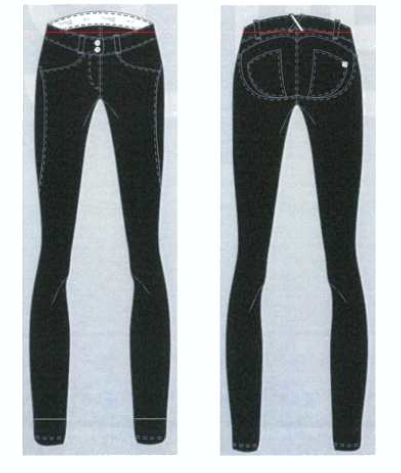
- That letter also included further images of the WR.UP jeans, compared to the First HUGZ Jeans:
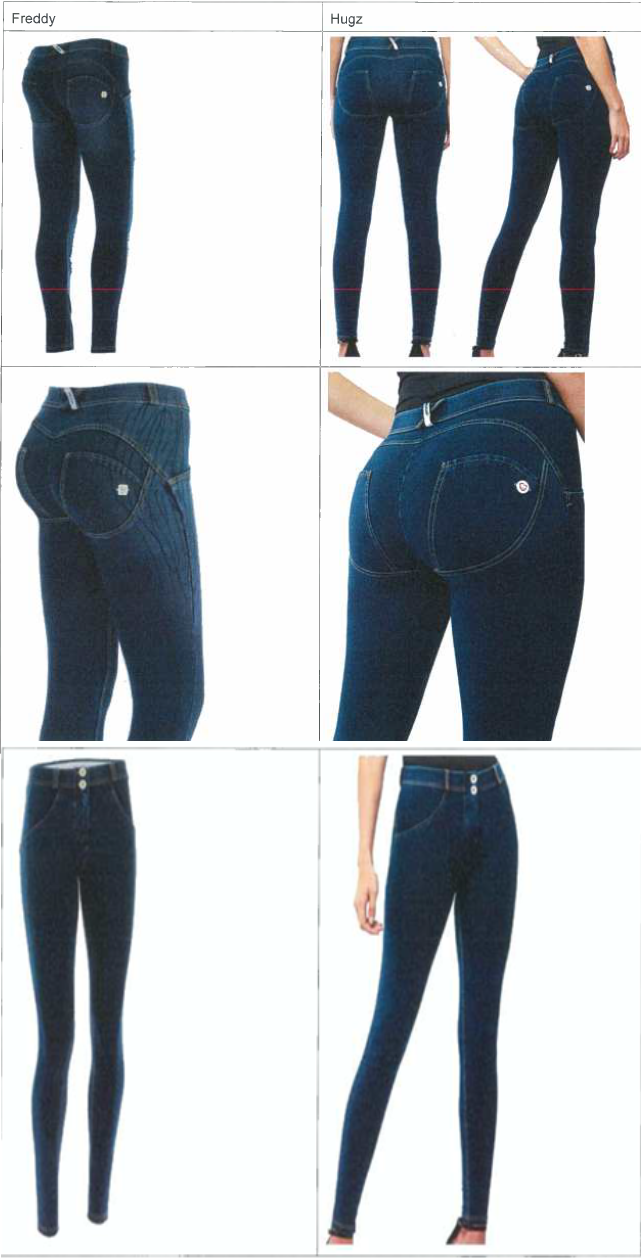
- As noted above, the Defendants admitted in the Amended Defence that they were obliged not to deal in products whose distribution in the UK would have been an infringement of the unregistered design right identified in the Letters. That includes the whole WR.UP jeans (as set out in the letter of 31 January 2019) and the seat of the WR.UP jeans as shown in the image in paragraph 126 above. The Amended Defence makes no pleading that those designs are invalid, or otherwise limited in scope. Even if the Defendants were to raise the same objections in relation to these two designs as they did in relation to the When Worn Design, the RSP Design, the Inner Parts Design and the JOTO Design, I would have rejected those objections for the reasons set out above. I have already allowed the Defendant's definitional objection to the When Worn Design, but the Letters do not make a claim to the shape and/or configuration of the design when worn. So that objection does not arise in relation to the designs reference to in the Settlement Agreement.
- Therefore, in my judgment, the Letters Designs and the SA Design subsist and are not invalid. The Second HUGZ Jeans are made exactly or substantially to those designs. They therefore would infringe.
- Both the Amended Particulars of Claim and the Amended Defence raise the issue of the licence of right which is available during the last five years of subsistence of unregistered design right under the CDPA. The Claimant submits that this is irrelevant to the question of breach of the Settlement Agreement. I agree. The question I must determine is whether or not the relevant article of clothing would infringe either the Letters Designs or the SA Design. It does not matter that the First and Second Defendants had offered to take a licence of right the products still infringe, even if no injunction may be granted against them (see section 239 of the CDPA). The offer of a licence of right limits the relief a court may grant: it does not render a design non-infringing.
- Therefore, in my judgment, the Defendants are in breach of the Settlement Agreement in relation to the Letters Designs and the SA Design.
Summary
- For the reasons set out above:
i) Claim 1 of the Patent is not invalid for lack of novelty or obviousness;
ii) The Second HUGZ Jeans fall within the scope of protection associated with claim 1 of the Patent;
iii) Unregistered design right subsists in the RSP Design, the Inner Parts Design and the JOTO Design but does not subsist in the When Worn Design;
iv) None of the pleaded designs is commonplace;
v) All of the pleaded designs are owned by the Claimant;
vi) The Second HUGZ Jeans are articles which have been made exactly or substantially to the RSP Design, the Inner Parts Design and the JOTO Design. If the When Worn Design were valid, the Second HUGZ Jeans are articles which have been made exactly or substantially to the When Worn Design;
vii) It is customary and conventional for women's jeans to bear branding elements on their rear pockets;
viii) The WR.UP jeans have been promoted by the Claimant by reference to the Freddy Get-Up;
ix) The Second HUGZ Jeans have been promoted by reference to the HUGZ Get-Up;
x) The Defendants have misrepresented that the Second HUGZ Jeans are connected in the course of trade with the Claimant;
xi) That misrepresentation has caused the Claimant damage; and
xii) The Defendants are in breach of the Settlement Agreement as a result of their dealing in a product which would have been an infringement of the Patent, the Letter Designs and the SA Design.
- The Claimant therefore succeeds on its case for patent infringement, unregistered design infringement (other than in relation to the When Worn Design), passing off and breach of the Settlement Agreement.



















